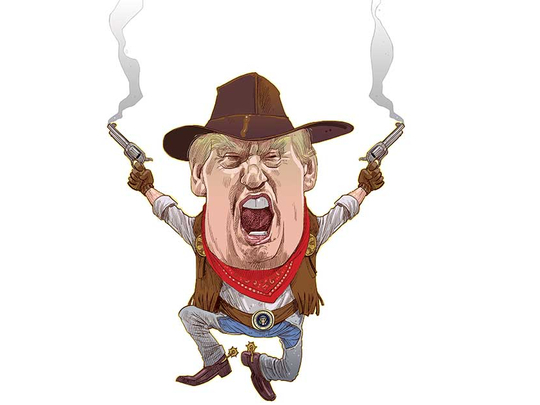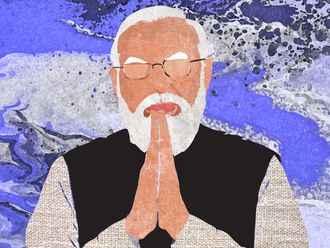
Mar-a-Lago is an extravagant winter retreat in Palm Beach, Florida. It was built by the heiress Marjorie Merriweather Post in the 1920s. She died in 1973, and left it to the US government as a residence for future presidents. The presidents failed to use it, however. In 1985, it was sold to a property developer, one Donald Trump. Trump’s initial offer had been refused, but he ended up getting the place for less by buying land nearby and threatening to block Mar-a-Lago’s view.
In the early 1990s, while continuing to live there, he also turned the place into a private club, adding on a vast ballroom and other frills. Unlike the snooty clubs of Palm Beach, Mar-a-Lago accepted black people and Jews, operating capitalism’s version of a “diversity” policy. Now that he is President of the United States, Trump calls the place his Winter White House.
I gather that he likes to govern the country by sitting in the lobby of the club. This allows him to hail passing advisers, plutocrats, friends and media and speak to them for the very few minutes which his short attention span prefers. The story of Mar-a-Lago tells you something about President Trump. He got the building which the government rejected. Then he got control of the government. Now he has turned the Trump building into a place from which he governs. As in the song, he did it his way. And like the “I” in “My Way”, he is a loud egomaniac, sentimentally in love with his own achievements. Yet there is something to admire in all this.
In a culture which claims to value outsiders but actually rewards conformists, he truly is an outsider. In a nation which, from the beginning, has always, in theory, exalted the idea of the citizen over that of the ruler, commander or official, he is the first Citizen President, the only one in the history of the republic never to have held public office or commanded armed forces. So he really is different, at a time when voters are deeply fed up with politicians who are “all the same”. To understand the last two weeks that have shaken the world, it helps to bear all this in mind. The cacophony of tweets, the hyper-activity of executive orders, the rush of officials trying to sweep up afterwards, the uproar of protest, the excitement of supporters - both what is good and what is bad flow from the unique character of this man and the unique way he has made it to the top. Take the good first. In the past fortnight, Trump has confounded predictions by seeming to take his campaigning promises seriously. He has frozen all new regulations now in process, introduced an all-but-blanket federal hiring freeze, speeded up environmental reviews for infrastructure projects and expedited the Dakota Access and Keystone oil pipelines. In a powerful attack on the semi-corrupt ecology of Washington life, he has banned executive appointees from lobbying their former agencies for five years after leaving them and from ever lobbying on behalf of a foreign government.
If former president Barack Obama had done the same thing, how the Left in the media would have cheered. Whatever you think of the issues, Trump has also been as good as his electoral word about starting to unwind Obamacare, pushing forward with the Mexican border wall, ending US participation in the Trans-Pacific Partnership trade deal and nominating a distinguished conservative to the Supreme Court. And, to the delight of many in Britain, he has embraced Brexit as the future and criticised the current structure of the EU as the past. All done at a cracking pace which has made it hard for his opponents to organise resistance.
On the other hand, the same pace has produced chaos. His 90-day ban on all entries from seven countries considered high terrorism risks, his indefinite freeze on Syrian refugees and his 120-day freeze on most other refugees may highlight how serious is the problem of the mass movement of people from Muslim countries; but it has also been semi-arbitrary, alienating and, because of the rush, sometimes impossible to operate sensibly. His style also makes other politicians feel that Trump is almost as dangerous a friend as an enemy. As, until quite recently, a Democrat, Trump has friends in Democratic high places, such as Senator Chuck Schumer of New York, but his combativeness makes it extremely hard for people like Schumer to do the bipartisan deals Trump will need in the Congress. So the Left, faced with Trump, is already starting to behave like the right-wing Tea Party under Obama, wanting to block everything.
Poor Theresa May, fresh from her highly successful visit to the White House, found herself embarrassed in Ankara by suddenly having to say something about Trump’s migration ban. He did not mean to, but he undercut her. Another example is the president’s call this week to the prime minister of Australia, Malcolm Turnbull. It is not true, as the anti-Trump Washington Post fake-newsily reported, that the president slammed the phone down. But it is true is that Trump then tweeted his annoyance at the deal, done by Turnbull with Obama last November, by which the US had agreed to take up to 1,250 Middle-Eastern refugees held by Australia in Nauru and Papua New Guinea.
The Trump tweet was unwise for two reasons. First, because Australia’s immigration policy is a model of Trump-like toughness. The country takes refugees, but insists on choosing whom. Determined to break the power of the people smugglers who ferry refugees to Australia in dangerous boats, it won’t have people dumped on it. Hence the deal with the US. Second, because Australia — one of America’s best friends in the world — is now left with a nasty taste in the mouth. On the phone to Turnbull, Trump said that he would honour his predecessor’s deal. But, by tweeting about how “dumb” the deal is, he makes them jumpy. Who gains from this way of doing business? There might be an answer to the question I just asked: it could be that Trump’s disruptive style is the key to his future success. Much of his appeal derives from the fact that he cannot be tamed. His method is to throw stones into the water and then hurry on to the next pond, leaving the slower-footed to get splashed. He knows how to, as modern economists put it, ‘’disintermediate’’. He cuts out middle men, bureaucrats, spokesmen, mainstream media to reach whomever he wants to reach in whatever way he wants to reach them.
This can refresh democracy. But on the whole, I find the Trump supporters I know feel less happy today than they did just before his inauguration. They think his rhetoric is a bit too dark and ill-humoured, and his methods too confusing. They want fewer fights picked and more real attention to economic progress. They like the energy, but fear that too much of it is wasted on rage.
— The Telegraph Group Limited, London, 2017
Charles Moore covers politics with the wisdom and insight that come from having edited The Daily Telegraph, The Sunday Telegraph and The Spectator.











